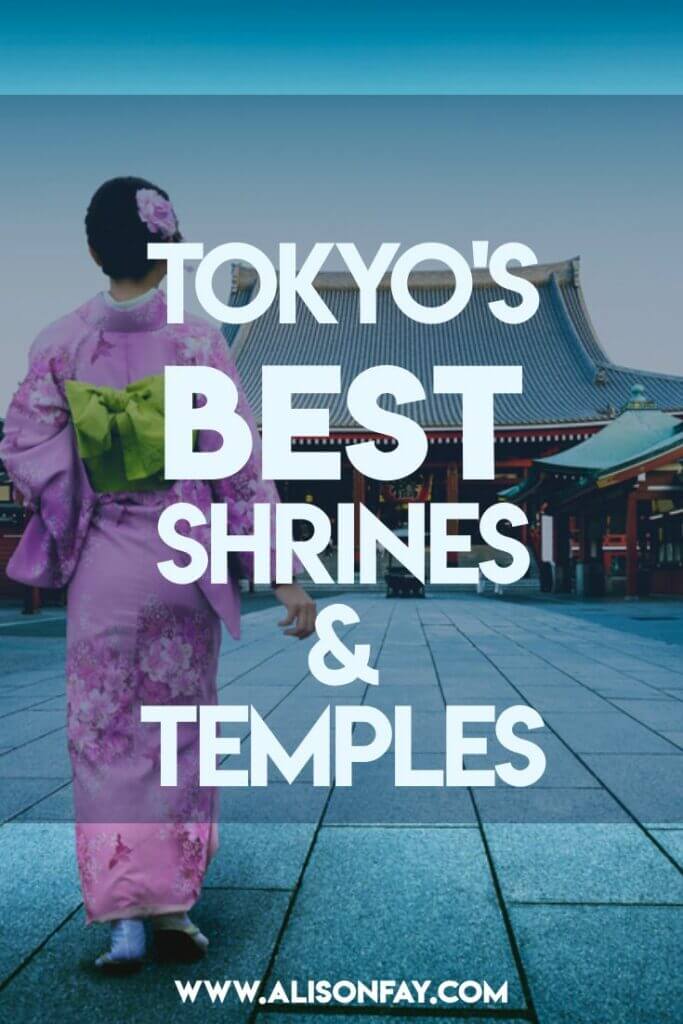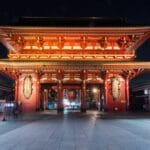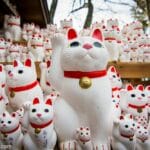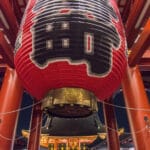I have asked some of the best travel bloggers, what they believe is the best shrine or temple in Tokyo and also included my favorite. This post covers why they like them, why you should visit them and what you can see & do at the best shrines and temples in Tokyo.
Zojoji Temple, Minato City
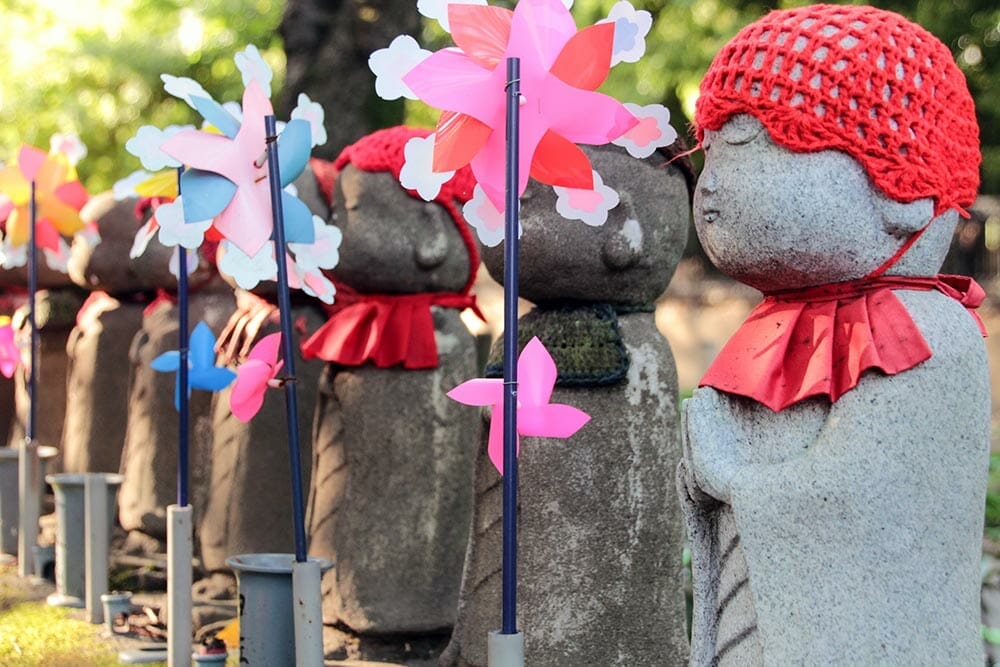
By Laura, Travelers Universe
Tokyo’s modern vibe and crazy fads might seem in direct contradiction with the city’s old temples and traditions. Yet they blend together beautifully, creating a glorious canvas for the visitor to embrace.
Look no further than the Zojoji Temple, one of the best places to visit in Tokyo. It’s considered to be among the most important temples in Japan and it dates all the way back to the 14th century. Later on, in 1598, it moved to its current location, as if in preparation for one of the most stunning sights in Tokyo. Nowadays, Zojoji Temple has the cheerful Tokyo Tower in the backdrop and although there’s little joyful about it, it’s still an oasis of peace and quiet in the middle of a bustling metropolis.
Zojoji Temple is comprised of several buildings, including the Tokugawa Mausoleum where most of Tokugawa family rests. But the most impressive part is the Unborn Children’s Garden with its 1,000 Jizou statues. The parents decorate them with red knitted hats, baby clothes and colorful windmills and set aside piles of stones to help their unborn child transition in the afterlife.
It’s a sad place, yet beautiful in every way. On a more cheerful note, Zojoji Temple made an appearance in ‘The Wolverine’ movie from the X-MEN series. And if you walk around the grounds long enough, you’re almost guaranteed to meet a bunch of cats! I befriended quite a few of them and was in seventh heaven for days!
Zojoji Temple is located close to the Onarimon station, Shibakoen station as well as the Daimon station. The entry is free and a visit to the temple can easily be paired with a visit to the Tokyo Tower.
Hatonomori Hachiman Shrine, Sendagaya
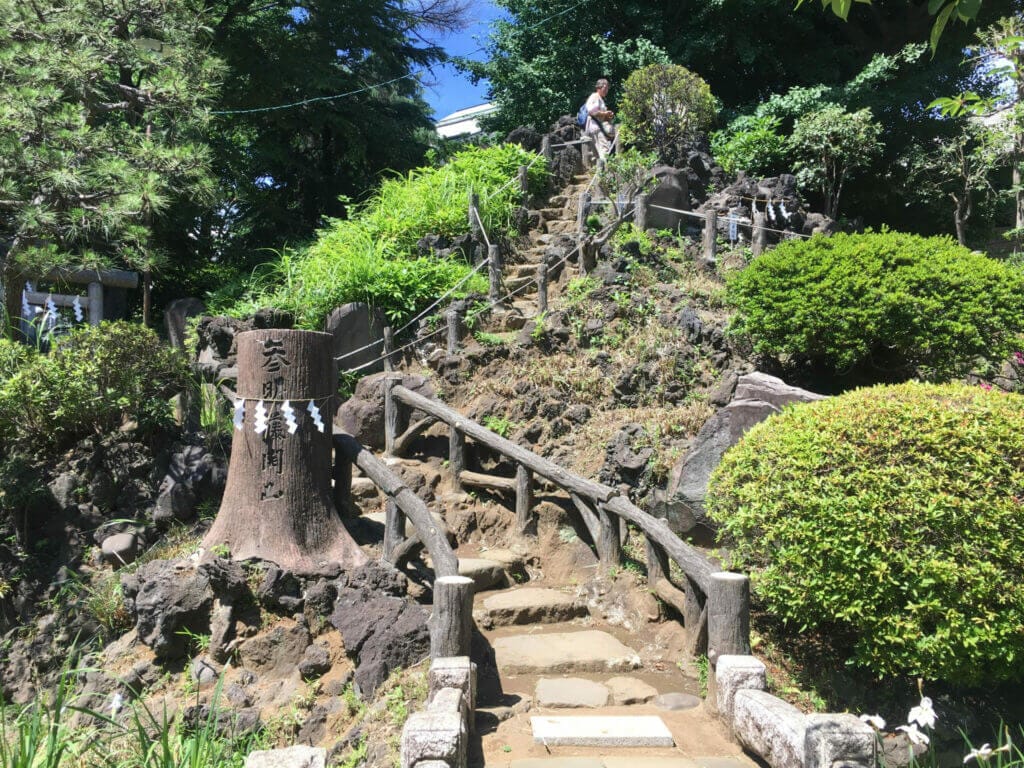
Hatonomori Hachiman Shrine by Erika van ‘t Veld, Erika’s Travelventures
This Shinto shrine dedicated to the Hachiman god of warriors is located just north of Harajuku and south of Shinjuku Gyoen in the Sendagaya neighborhood. It can be accessed by a short walk from the Sendagaya JR station on the JR Chuo and Chuo-Sobu Lines. It is also a short walk from Yoyogi Station on the JR Yamanote Line.
Aside from being a scenic and peaceful haven in Tokyo’s bustling city center, Hatonomori Hachiman Shrine has two unique features that set it apart from other shrines. The first is the Noh theater stage, which is one of the main buildings within the shrine complex.
Sometimes you can see practice performances taking place from outside of its glass enclosure. The second feature is the fujizuka, which is a 6-meter mound built to imitate Mt. Fuji. It is said that those who are unable to climb to the 3770m summit of Mt. Fuji itself, will still be similarly blessed from climbing this fujizuka. If you climb up this rocky fujizuka, there are smaller shrines built along the path, and a nice view from the top as well!
Other features of the shrine include a small shop where you can purchase omamori blessings and omikuji fortunes, a temizuya washbasin to purify yourself, and the main shrine to make a prayer and ring the bells. Although Hatonomori Hachiman Shrine is one of the smaller shrines, there are Japanese and English instructions on how to purify yourself and pray at the shrine.
Meji Shrine, Ueno
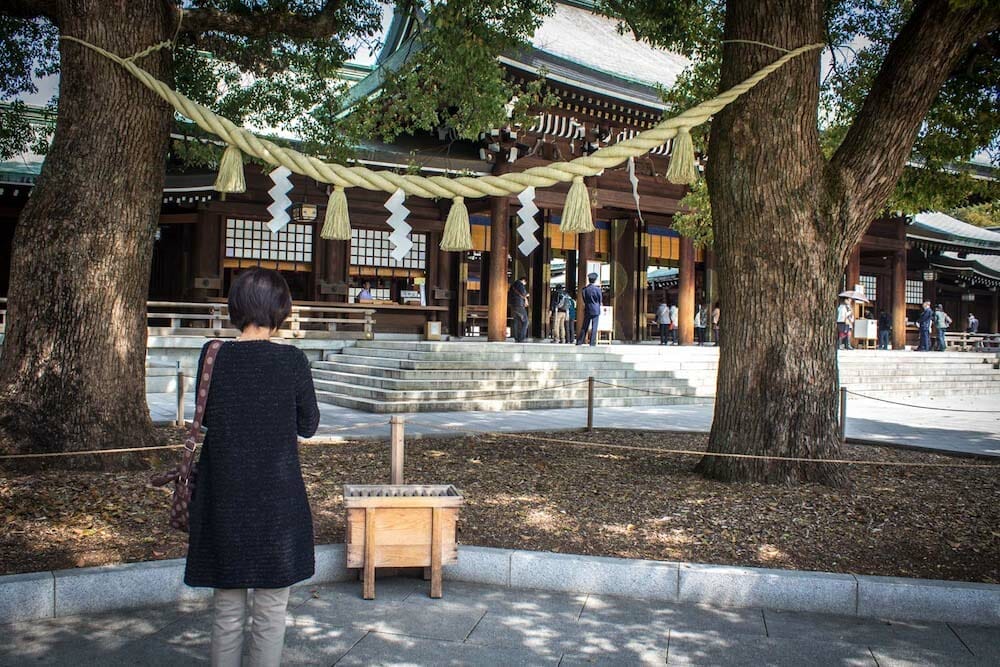
By Michael, Time Travel Turtle
The Meiji Shrine is one of the most important in Tokyo. It is dedicated to Emperor Meiji, who died in 1912 after overseeing a period in Japan’s history when the country opened up to the world, paving the way for the international powerhouse that we know today.
Emperor Meiji gets a lot of credit for creating a modern Japan that still preserves its unique traditions. So it’s no surprise that the people of Japan wanted an appropriate shrine to honour their late emperor.
Even the large forest that surrounds the main building was donated by the public, with more than 100,000 trees paid for by the general public. In the central complex, there is also a sacred music hall, buildings that hold art galleries, a treasure museum, and a martial art training hall.
It’s very easy to visit the Meiji Shrine because it is just on the edge of the popular shopping district of Harajuku. For visitors to Tokyo, it’s likely you’ll be exploring this area anyway so you can just pop over and see the shrine – or get public transport to Harajuku just to visit the site.
Entrance is free to the main area and the forest. It’s my favourite shrine in Tokyo because it feels like such an oasis to walk through the wooden torii gates and into the peaceful forest, even though you’re still in the centre of the city. It’s a fitting tribute to an emperor who kept traditional Japanese culture alive while also encouraging Tokyo to become the metropolis it is today.
Nezu Shrine, Ueno
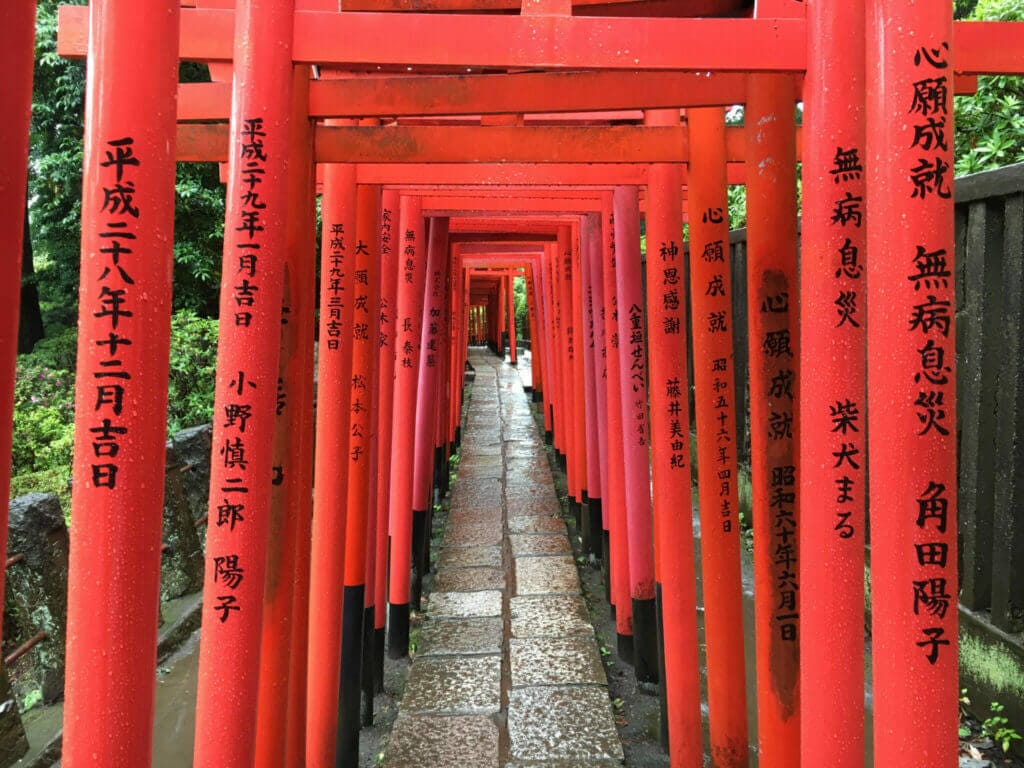
by Erika van ‘t Veld, Erika’s Travelventures
The Nezu Shrine is one of the oldest shrines in Tokyo, and was built in its location as it is today during the Tokugawa dynasty in the 1700’s. When the capital of Japan was moved from Kyoto to Tokyo by Japan’s Emperor Meiji, he sent his envoy to Nezu Shrine to pray to the gods in his place. This is a popular shrine for traditional Japanese weddings and photo-shoots to take place and is home to a small shop selling omamori and omikuji, a temizuya washbasin, and a large grounds area complete with koi ponds. Somehow the temple remains off the tourist radar, so it’s possible to escape the crowds within the grounds of this Shrine. Aside from the beautiful architecture of old Japan, the most memorable feature here is the Torii gates.
These red Shinto gates, the most famous ones being the 1000 Torii gates in Kyoto, are densely lined up to create a tunnel effect across one side of the shrine complex. The gates can be enjoyed any time of the year, but the best time to visit Nezu Shrine is in late April when the shrine’s wall of azalea flowers are in full bloom. The closest stations to Nezu Shrine are Todai-Mae Subway Station on the Namboku line, and the Nezu Subway Station on the Chiyoda line. If you’re down for a long stroll, the Nezu Shrine can be reached within 20 minutes on foot from the Yanaka Ginza area next to Nippori Station, or 20 minutes coming from Ueno Park in the other direction.
Gotokuji Temple, Setagaya

By Helen, Differentville
When you first arrive at Gotokuji temple in Tokyo’s Setagaya district, you’ll think it’s peaceful. You’ll admire the 3-story pagoda in the middle of the grounds and wander around the Japanese cemetery. But then you’ll notice something – cats. They’re drawn on the ema – the wooden plaques on which people write their prayers and wishes. You’ll see white waving cats for sale in the temple’s small shop. And then you wander around the corner to a small area about 2m by 3m and you’ll be surrounded by literally thousands of white waving cat statues – from tiny ones about 3cm high to the giant ones you spotted in the temple shop for an eye-watering sum – and you won’t quite believe your eyes.
The story of how Gotokuji came to be full of waving cats goes back to Edo times. Legend has it that one day a feudal lord was traveling past the temple when a cat beckoned him inside. He followed it and soon after a thunderstorm started. To thank the cat for helping him shelter for the storm, he made the temple (that is now Gotokuji) his family shrine. Soon local people began bringing cat statues to give thanks for having brought this generous lord to their neighbourhood. And it stuck.
You can get to Gotokuji easily from Shinjuku station by taking the Odakyo Odawara line to Gotokuji station. The temple is about a 10-minute walk south through the small town of Gotokuji which is also full of cute cat paraphernalia. Our top tip is to go early. Gotokuji opens at 6 am which makes it one of the great things to do in Tokyo in the morning when many other sights are closed. This also helps you beat the crowds – the cat area really is pretty small. If you want to leave your own cat though, you’ll need to wait until the shop opens at 8 am to buy one.
Sengakuji Temple, Minato City
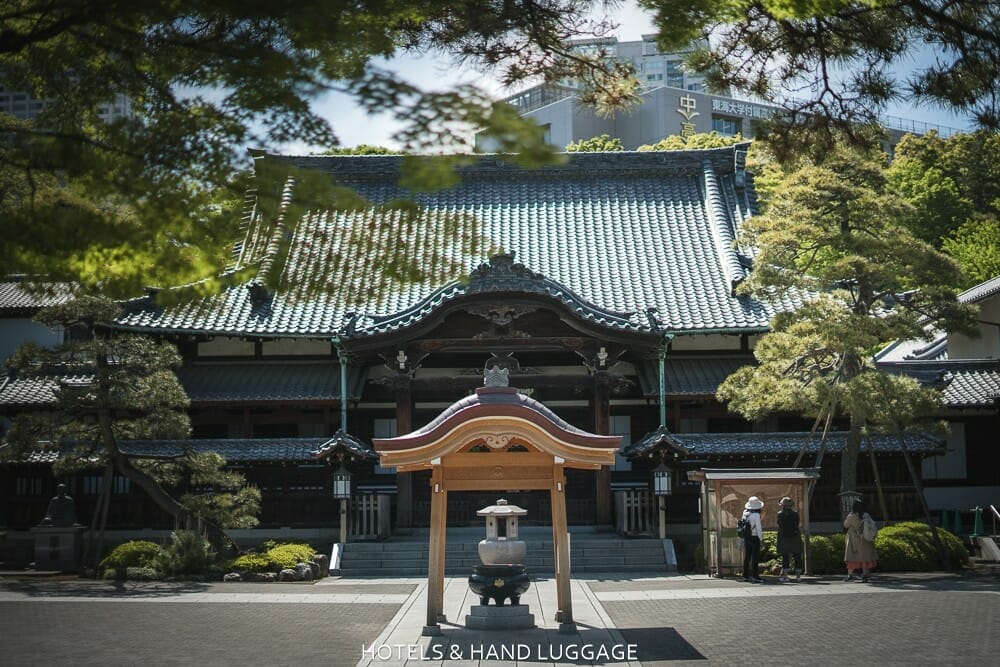
By Sarah & Andy, Hotels & Hand Luggage
Sengakuji is a Buddhist temple, dating back to the 17th Century. It’s renowned for its graveyard where the legendary 47 Ronin and their former master are buried. Although this temple can often be overlooked if you’re interested in learning more about an important part of Japanese history and the fascinating samurai culture a visit here should not be missed.
The 47 Ronin was a group of samurai who were sentenced to seppuku (Japanese ritual suicide) for avenging their master lord Asano Takuminokami in the 18th Century. The samurai knew their plan for avenge would result in their death, but their loyalty left them undeterred in order to regain their master’s honor. During our visit, there were many people at the graves showing their respects and placing incense or offerings on the gravestones. It was incredible to see the great respect the Japanese people have for the 47 Ronin and the sacrifice the samurai’s made.
A festival is held annually at Sengakuji Temple on the 14th December for the anniversary of the avenge. Due to the story of the 47 Ronin being one of the most famous in Japanese history, this festival attracts a huge crowd.
On the grounds of the temple, there is also a small museum showing a video explaining the history of the temple and the story of the 47 Ronin. Inside there are also letters, armor and various other artifacts relating to the samurai. Across from the museum, there is also an annex containing mannequins of the 47 Ronin dressed in the clothing and armor they wore on their mission.
Sengakuji Temple is free to visit, but if you would also like to visit the museum it will cost 500 Japanese Yen.
Sengakuji Temple is located in the Minato Ward in Tokyo and is very near to Sengakuji subway station on the Toei Asakusa subway line. You could also use the JR Yamanote Line and get off at Shinagawa or Tamachi Station, but you will then need to walk for 15-20 minutes to reach the temple.
Kanda Myojin, Chiyoda

By Helen, Differentville
Going to a temple to get a talisman that protects your hard drive really is one of those ‘only in Tokyo’ moments, but when the temple in question is close to Akihabara, Tokyo’s biggest area for all things anime, techno and geeky, it becomes less surprising.
Kanda Myojin is also where people come to pray for success in business and marriage as its devoted to three Gods – Daikokuten, the god of marriage, Ebisu, the god of fishermen and business and a feudal lord called Taira Masakado. Statues of all three can be found in the grounds –including the largest statue of Daikokuten in Japan. If you’re very lucky, you might see the mode of transport for these gods wandering around. The shrine has a pony which is, apparently, there in case any of the Gods want a lift from A-B. He seems to spend most of his day munching hay and being taken for walks around the grounds by the staff.
If you’re in Tokyo in the middle of May in an odd-numbered year Kanda Myojin is home to one of Tokyo’s most important festivals Kanda Matsuri which sees people carrying portable shrines from the shrine and out into the streets nearby. It’s also one of the temples that Tokyoites like to visit on New Year’s Day where people pray for good luck in the year ahead – up to 300,000 people can visit on this day alone.
If you visit, have a close look at the prayer plaques at the small temple to the back left – they’re covered with anime characters. It’s definitely one of the more unique things to do in Tokyo.
Sensoji Temple, Asakusa
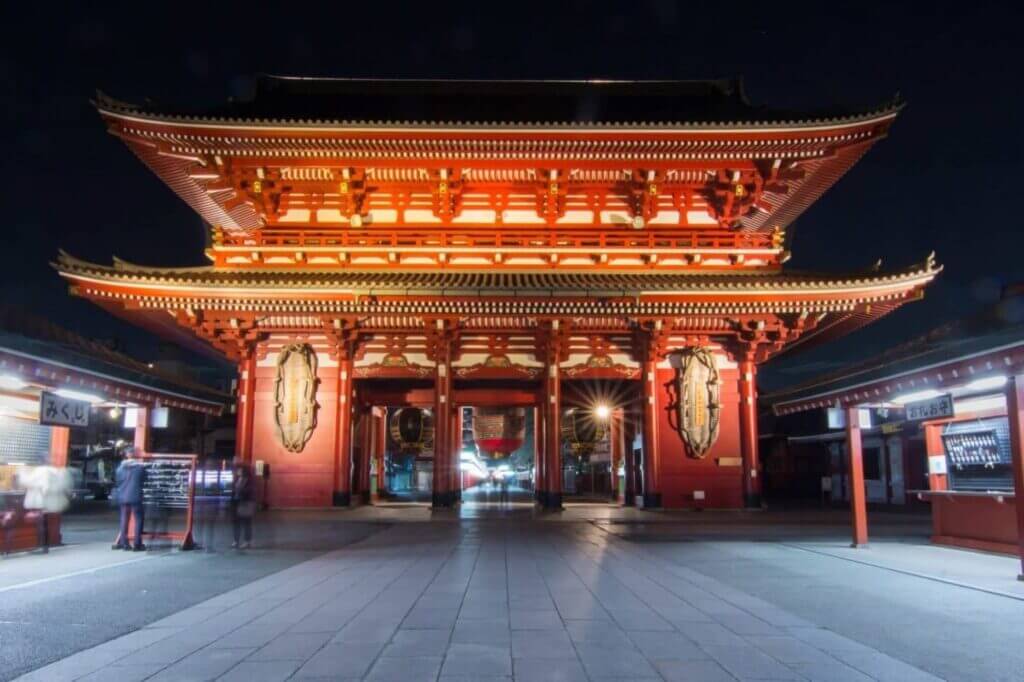
Located in Tokyo’s Asakusa district, Sensoji is Tokyo’s oldest temple. The temple was originally built in 645, for the Goddess of Kannon (Goddess of Mercy), and restored after World War 2.
When visiting, you’ll most likely approach Sensoji through Kaminarimon (Thunder Gate), which is a really magnificent structure which leads you into Nakamise shopping street. This historic street is full of little stores, selling souvenirs such as omiyage and some really good food such as Kibi Dango. At the end of Nakamise, you’ll walk through another gate – Hozomon. This brings you out into the temple grounds, which contain the Main Hall, Five-story Pagoda, and Asakusa Shrine.
Before visiting the main hall, make sure to purify yourself at the Chozuya, by pouring some water onto your hand and mouth. When you get to the main hall, you’ll see an incense burner called a Jokoro. It’s said that the smoke from the incense can help heal you or make you smarter.
While you cannot go inside the main hall, you can look through the doors/windows, and pray at the front. During your visit, why not purchase a Omikuji? These are strips of paper that contain fortunes, that offer a blessing or curse. If you receive a bad (kyo) fortune, make sure to tie it onto the metal wiring/branches.
If you don’t have time to visit Sensoji during the day, make sure to visit it at night when it is lit up. This is also a much quieter time, allowing you to enjoy a peaceful walk around the grounds. Whether you choose to visit during the day, or at night, Sensoji Temple is a really beautiful place to visit and enjoy Japanese Culture.
